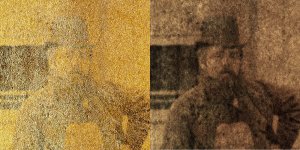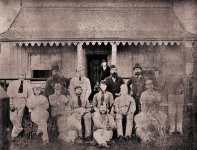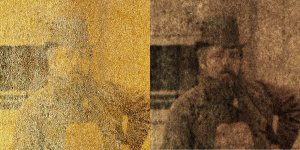Soldato
Knew someone would help you
Did a great job on it too considering the
Original picture
Did a great job on it too considering the
Original picture
You're welcome


Have you tried Ian denoise 2019 beta 3 found in g'mic plugin for gimp 2.10.20? It is pretty good at removing the grain and can do a comparison between the original and the degrained to pick up original detail. Ofcourse an 145 year old photo may well be best left grainy.If you're expecting a restoration to reach something where there is no noise and grain, all the details back etc ... you're not going to get it. And even if you did, it just simply wouldn't look right. I went through a similar process with a few old photos of the farmhouse I live in. Long story short, the grain and noise adds to the final result looking better. Cant explain why, but they just seem to print out better and look better on the wall that way.
In terms of your photo, ditching the sepia goes a long way to removing the light faded section on the right. The 2 darker bands could be reduced a lot as well. You could also likely add some more detail through some smart use of dodge, burn and cloning tools.
So this was done by making it grayscale first, cloning sections of the roof against each other to even it out and remove the bands. Then some dodge and burn to reduce the banding across the team. Finally, a gradient map to give it back some colour afterwards. Its not perfect, but I was just playing about with the tools seeing what would and wouldn't work. It could be a lot better.

The image you have uploaded isn't particularly large either. Can you upload a larger version which is unaltered?
Thanks for this information, this is sure to help me. I was here for encoding settings for Staxrip, AMD and deinterlacing (after looking for help on videohelpforums and youtube) but this info is a huge bonus.Its the first photo I've ever restored like that. There were a couple of points that really brought the image quality forward, which if anyone is interested ( from getting here from google searches etc ), or I cant remember what I did later down the line, then here goes.
I found working with the coloured scans better than the non-coloured ones. Colour simply had more data to work with. In simplistic terms: grayscale only has a single value from 0-255, colour has 0-255 for red, green and blue ... so 3x times the data (potentially) to work with to bring out details. I wasn't bothered about the colour it looked working through it the process, as long as more detail came out.
1st big thing was getting rid of all the tiny tiny white spots that were all over the image ( not the big ones ). A lot of the spots were only 1 pixel wide and they were across the whole image. After a number of methods tried, to get rid of them, I:
- Created a duplicate layer of the image, one on top of the other.
- On that top layer, I did a selection by colour range (i.e. white, or just about white). This selected all the tiny white spots.
- Deleted that selection from the top layer so that where there was white spots on the top layer, it was now transparent to the layer below.
Trouble is that the layer below had all the white spots too, so you then saw all the white spots again. After a bit of messing around, I came up with the idea of blurring the bottom layer below. this meant that all the white spots got blurred into an average of the colours around them. So now, where the top layer was transparent from deleting all the white spots, what you got was a blended average filling in the white spot. Great benefit of this is that detail is never lost from the top layer as it didn't need blurred.
Time was then spent filling in the bigger white spots using content aware healing, clone tools etc, and also trying (with limited success) to remove the 2 dark vertical bands.
2nd big thing was the multiply mode of blending layers. Take the photo, duplicate it, and make set the top layer to Multiply. Too hard to explain how it works, but it basically brings out colour and detail that you just wouldn't get by adjusting brightness and contrasts alone. This step is what brought out the faces on people and the scores on the board.
Simples !
[Edit]
Here is a before and after. Best viewed at 100%. Looking at it now, even I can't believe how good it came out



